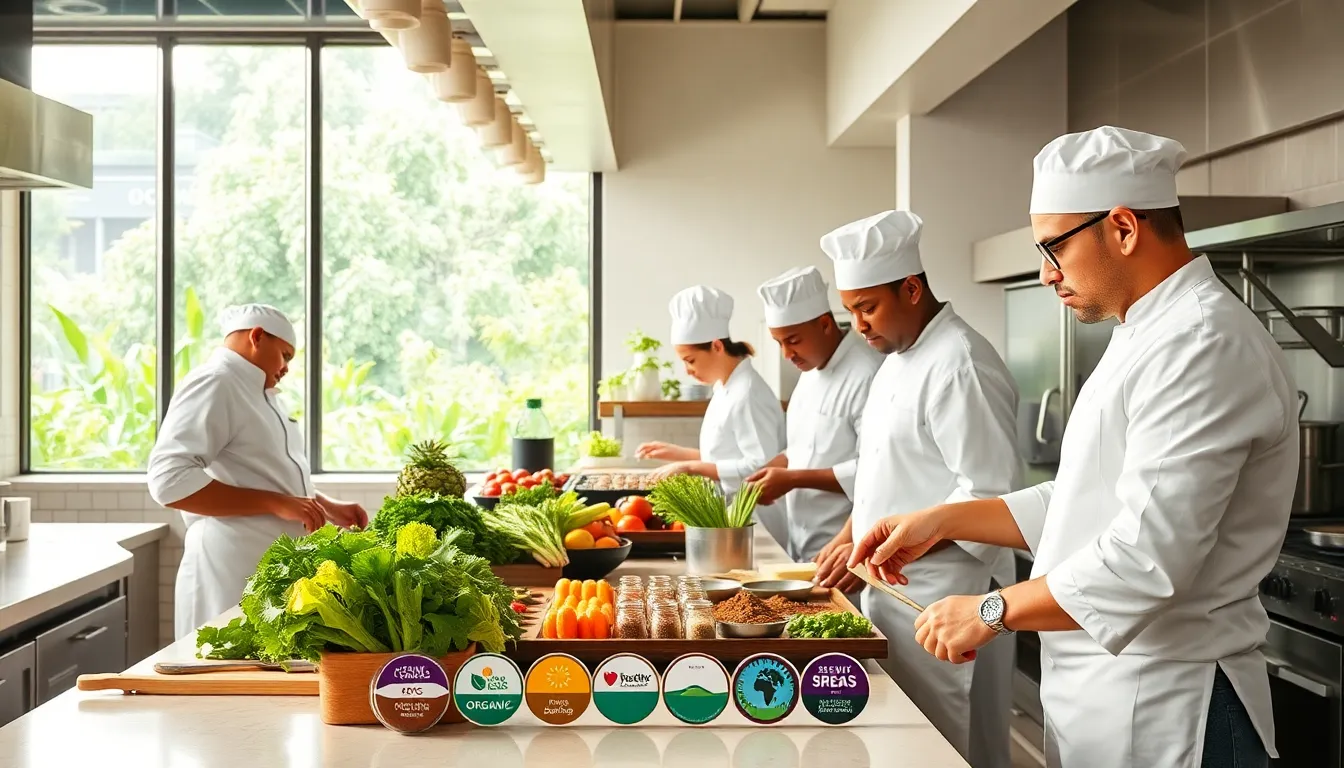Table of Contents
ToggleIn the rapidly evolving world of culinary delights, the food industry is like that friend who always knows the trendy new dance moves, and you’re just trying to keep up. From sustainability to plant-based proteins, it’s a whirlwind of flavors, ethics, and innovation. Whether you’re a foodie looking to spice up your dinner table or a business owner aiming to stay ahead in the market, understanding these trends isn’t just important, it’s essential. So grab your apron and let’s jump into what’s hot and happening in the food landscape.
Sustainability and Ethical Sourcing

Sustainability is no longer just a buzzword: it’s a necessity. Restaurants and food brands increasingly turn to ethical sourcing strategies, ensuring they not only serve delicious meals but also support the planet. The focus has shifted from merely meeting consumer demand to embracing practices that protect natural resources for generations to come. This means sourcing ingredients locally, using less plastic, and minimizing waste. Companies that adopt sustainable practices are seeing a positive response from eco-conscious consumers who are willing to spend a little more for food that aligns with their values.
The Rise of Transparency
Consumers today are more informed and curious than ever before. They want to know where their food comes from and what processes it underwent before arriving at their plates. Transparency in food sourcing allows brands to build trust, establishing a connection that goes beyond just the menu. Businesses that are upfront about their sourcing, like farm-to-table operations, are winning over a market segment that prioritizes feel-good eating.
The Role of Certifications
Certifications such as organic, Fair Trade, and non-GMO are gaining traction. These labels serve as quick indicators for consumers, helping them make informed choices. When a product carries a certification, it often signifies a commitment to better practices, from ethical animal treatment to environmentally friendly farming techniques.
Plant-Based and Alternative Proteins
Plant-based diets are not just for vegans anymore. The explosion of interest in alternative proteins is proof that consumers crave variety in their diets, without sacrificing flavor. From burger patties made of pea protein to tofu that can fool even the most devoted carnivores, the offerings are as exciting as they sound.
The Purpose Behind Plant-Based Eating
Many individuals are exploring plant-based options for health benefits. They’re discovering reduced cholesterol levels, lower blood pressure, and improved energy. In response, the food industry has risen to the challenge, developing innovative plant-based products that cater to taste and texture, making it easier for people to adopt a more plant-centric diet.
Beyond the Plate
The plant-based movement isn’t just a trend: it’s becoming a staple on menus worldwide. Major fast-food chains are introducing meatless alternatives, catering to consumers who might not want to commit fully but are interested in reducing their meat intake. So, a new age of accessibility has emerged, igniting conversations about wellness, sustainability, and culinary creativity.
Technological Innovations in Food Production
Technology is revolutionizing the way food is produced and consumed. From smart farming techniques that use drones to monitor crop health to IoT (Internet of Things) systems that optimize inventory management, innovation is at the forefront of the food industry.
Automation in Food Production
Many factories are now embracing automation to enhance efficiency. This means faster production times and minimized human error, ensuring that food safety remains a top priority. Robotic arms are packing goods and machines are sorting ingredients, making processes smoother and reducing labor costs.
Food Tech Startups
The rise of food tech startups has brought forth groundbreaking solutions, from vertical farming to lab-grown meat. These companies are changing the conversation around food production by combining technology and agriculture. For instance, lab-grown meat addresses ethical concerns surrounding animal agriculture while providing a viable protein source, attracting investors keen on sustainable solutions.
Health and Wellness Trends
Health consciousness is soaring, and the food industry’s responding in kind. Bold flavors may catch the eye, but nurturing bodies is the name of the game. Dining options are not only becoming refocused around health benefits, but they also aim to support an overall holistic lifestyle.
Nutritional Transparency
Consumers are now more aware of what goes into their food. Detailed nutrition labels are expected on every product, letting buyers make informed choices based on dietary restrictions or health goals. Hence, brands are adapting by offering healthier alternatives, less sugar, more whole grains, and balanced portions.
Functional Foods
Also, the rise of functional foods is notable. Foods fortified with vitamins, probiotics, and omega-3s are sought after for their health benefits. From gut health to immune support, consumers are selecting items that do more than taste good: they want products that contribute positively to their well-being.
Global Flavors and Fusion Cuisine
Travel may have slowed during the pandemic, but people’s taste buds didn’t get the memo. Global flavors are making waves in kitchens across America, introducing unique cuisines and fusion dishes. This trend enriches palates and encourages exploration.
The Spice of Life
Chefs are using spices from far-off lands, think za’atar from the Middle East, harissa from North Africa, and sambal from Southeast Asia, to enhance dishes. This rich tapestry of flavors not only complements traditional recipes but also reinvents them, allowing chefs to create bold new icons in the culinary scene.
Cultural Exchange on the Plate
Fusion cuisine continues to thrive, making unexpected pairings a delightful norm. Picture Korean BBQ tacos or sushi burritos. By merging culinary practices, chefs pay homage to cultural roots while creating something entirely fresh. This movement is all about exploration, acceptance, and celebrating diversity.
Food Delivery and E-Commerce Growth
With the rise of food delivery apps and e-commerce, convenience has taken the front seat. Busy lifestyles mean people want meals that come to them, whether it’s a hearty pizza or freshly prepared sushi. The pandemic only accelerated this trend, making online orders a staple.
Subscription Meal Kits
Subscription services are booming. These meal kits offer pre-portioned ingredients along with recipes that cater to various dietary needs. People enjoy the ease of cooking without all the hard work of planning, after all, who doesn’t love having new culinary adventures delivered straight to their door?
The Shift in Shopping Habits
Grocery shopping has also transformed under the influence of e-commerce. Consumers now enjoy the ability to purchase groceries online, with many retailers offering same-day delivery options. This trend has made it easier to access fresh produce and pantry staples.







